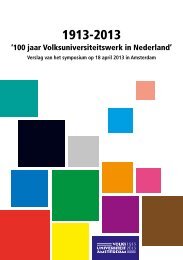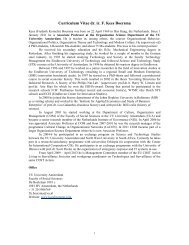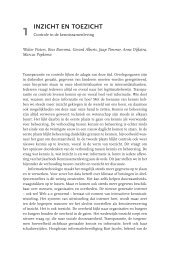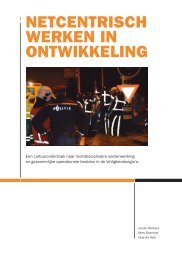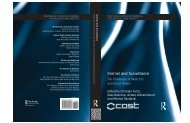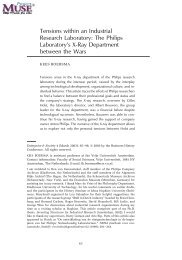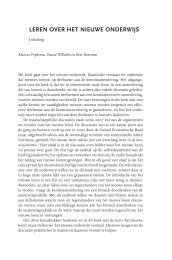Surveillance and Society - Kees Boersma
Surveillance and Society - Kees Boersma
Surveillance and Society - Kees Boersma
You also want an ePaper? Increase the reach of your titles
YUMPU automatically turns print PDFs into web optimized ePapers that Google loves.
<strong>Boersma</strong>: Liminal <strong>Surveillance</strong>crowds <strong>and</strong> busy streets. You can just sit there <strong>and</strong> check on things. Makes it prettyconvenient.On top of that, the emergency operations center set up during Unofficial (<strong>and</strong> for that time only), meantthat there were two different hierarchies working at the same time:…the operations center is in charge of all the people working on Unofficial St Patrick’sdetail… But there is still the regular police site working: regular patrol units, regulardispatchers, everything like that. So, there is still answering the calls, you know, that comein through 9-1-1 <strong>and</strong> stuff like that, <strong>and</strong> we are still dealing with a lot of stuff so that doesoverlap, but it is two separate things going on at one time.Since 2010, the emergency operations center, where most of the emergency response officials cametogether for this particular event, has been housed in one of the buildings of the Illinois Fire ServiceInstitute (IFSI) (Schenk 2011). During the 2012 event, one could find fire fighters, dispatchers, cityofficials, <strong>and</strong> members of the (privatized) ambulance service gathered in the same room. The presence ofthe police—campus, local, county <strong>and</strong> state—was dominant: there were police officers from the cities ofUrbana <strong>and</strong> Champaign, the county, the State Liquor Control Board, <strong>and</strong> the University of Illinois PoliceDepartment. The officials use this room more often during events like football games <strong>and</strong> for trainingexercises. However, the way they use it during Unofficial is unique.The whole operation at the time of the event, not including preparations, took about twenty hours: theactivities in the room started about 6:30 am on Friday <strong>and</strong> continued until about 2:30 am the followingday. The officials worked in shifts of eight or twelve hours (depending on their organizational rules), butsome of them (especially those involved in CCTV surveillance), stayed much longer in the room. Also,the numbers of police officers on patrol increased from eleven (the average number of police officers onpatrol during normal days) to around one hundred for Unofficial, some of them undercover. People whovisited the room during the day, such as municipality officials, almost immediately responded to theCCTV images. Questions such as “Can you zoom in on this or that” were frequently asked. One of thevisiting officials gave a vague promise: “The system was useful last time; I wish we could install morecameras permanently. Please let me know how we can arrange that!”The projected images of the CCTV cameras <strong>and</strong> the data from the emergency control room offeredparticipants a common focus for discussing strategies <strong>and</strong> planned actions. In addition to the alreadyinstalled cameras, law enforcement used fifteen additional, temporally installed cameras (called redeployablecameras, Waples <strong>and</strong> Gill 2006) pointing at ‘hotspots’ such as buildings judged to be high risk,<strong>and</strong> the entries of cafes, bars, <strong>and</strong> restaurants. The screen on the left h<strong>and</strong> side of the room was used toproject information from the 9-1-1 Emergency Response Center. In this way the officers could see theincoming calls <strong>and</strong> the positions of the patrol cars. The CCTV images/footage were projected on threescreens in the middle of the room, taking a central location. The center screen was called the hotspotwindow, since the most important or—at a particular moment in time—the most relevant images (in termsof risk <strong>and</strong> security) were projected there. The two screens on the right h<strong>and</strong> side of the room projected theimages of the weather forecast <strong>and</strong> streams from social media websites, in particular Twitter <strong>and</strong>Facebook.<strong>Surveillance</strong> as practiceDuring Unofficial it was quite obvious what was considered unwanted behavior, at least to the policeofficers: wearing green shirts or being in a group with ‘Greens’ was enough to attract the police’sattention. “Keep an eye on the Greens” was a remark that could often be heard throughout the day. Theirbehavior made the Greens the ‘usual suspects’, as overly watched persons are called in CCTV surveillance<strong>Surveillance</strong> & <strong>Society</strong> 11(1/2) 113



